When The Mandalorian series began to air in 2019, one of the things that captured many fans’ hearts right off the bat (including my own) was Din Djarin’s battered bounty hunter vessel the Razor Crest. It fit perfectly into the famously “lived-in” Star Wars universe of the original trilogy, and so it’s fitting that 75331 The Razor Crest is the first vehicle from outside the movie trilogies to receive the Ultimate Collector Series (UCS) treatment. At 28 inches long (72cm), the UCS Razor Crest includes 6,187 pieces and features minifigures of Din Djarin, Kuiil, a Mythrol, Grogu, along with a brick-built blurrg. Revealed just a few days ago, the set will retail for US $599.99 | CAN $759.99 | UK £519.99 and will be available Oct. 3 for VIP members with general availability Oct. 7.
The LEGO Group provided The Brothers Brick with an early copy of this set for review. Providing TBB with products for review guarantees neither coverage nor positive reviews.
Unboxing the set and contents
The Razor Crest comes in a large black box that’s thinner than the almost cubic boxes of the 75192 UCS Millenium Falcon and 75313 UCS AT-AT, similar to the box for 75309 UCS Republic Gunship. While I didn’t weigh the box, it’s definitely quite full and feels appropriately hefty for a 6,000-piece set. As typical with adult-focused sets, the back of the box portrays a variety of details of the model along with screenshots from the show.
Inside, the set is divided into two sections via inner boxes. The boxes are decorated with artwork from the show on several faces, and they look so nice that it’s a shame they’re only visible momentarily between opening the main box, and dumping the parts out to begin building.
Box 1 contains 25 bags numbered 1-19, along with two cardboard packets, each of which protects a thick instruction manual. The UCS Razor Crest follows in the footsteps of sets like 75159 Death Star as it comes screen-accurate straight out of the box: which is to say, in a million pieces. (too soon?)
 The second box contains another 23 bags numbered 20-36, another packet of instruction manuals (this one has two thinner manuals together), and the loose 8×16 plate for the info placard.
The second box contains another 23 bags numbered 20-36, another packet of instruction manuals (this one has two thinner manuals together), and the loose 8×16 plate for the info placard.
The four manuals have bright yellow covers showing exactly what parts of the model they correspond to. While I can’t deny they clearly convey their message, I find the look pretty ugly compared to manuals in other premium sets, notably Technic, where the flagship sets continue to one-up the Star Wars in both presentation and printing. Those sets have eschewed stickers in favor of printing even for the info placard. Here you’ll find a large sticker sheet packaged with one of the manuals in box 1.
As is typical with adult-focused sets, the manual kicks off with several full-page spreads of behind-the-scenes info on both the on-screen ship and the LEGO model.
While the majority of the Razor Crest’s elements are standard fare with boatloads of light grey for the exterior and a smattering of other colors for hidden structural elements. There are fewer odd-colored elements here than in many builds because the majority of the parts are visible in the finished model since the interior is mostly accessible. There are a handful of interesting parts worth noting here, though. Starting off, there’s just one all-new element introduced (not counting Kuiil’s head sculpt that we’ll look at later). The 4×4 tile (part 1751) gets introduced, finally providing an intermediary between the 2×2 and 6×6 tiles. The set includes 19 of them in light bluish-grey.
Next up are a few recolors and prints; I didn’t exhaustively scour the set’s 6,000+ pieces for recolors, but these are the ones that stood out as noteworthy. The newly introduced Technic friction half-pin, previously only available in red, gets an update to a very useful color with 5 dark bluish grey ones included. The set also includes quite a few red ones too. Similarly, the curved slope 3×3 corner element, introduced in last year’s 10283 NASA Space Shuttle Discovery, appears for the first time in light bluish grey (you’ll get just 2). Meanwhile, the bar 2L with stop ring makes an appearance here in red, which has previously only been available in the Ferry Captain from Minifigures Series 23.
There are also three new prints: left and right versions of the canopy printing in the curved corner panel, and new eye prints for the blurrg on 1×1 round tiles (an extra is included).
The build
Cracking into Bag 1 of Box 1 is always an exciting prospect, with almost 50 more bags to go on a set of this size. The build begins humbly, if predictably if you’ve built many large LEGO models in the past few years, with a thick section of Technic framing.
This quickly balloons out to front and rear and immediately we can begin to see the Razor Crest’s footprint take shape. Somewhat unusual for a set of this size, there are already some finished details laid down at this early stage. It’s been a while since I’ve watched the first seasons of The Mandalorian, so I don’t recall if this dark orange cube is something specific from an episode; let me know in the comments if you’ve got an idea.
 The build quickly moves on to adding more of the interior, as many of the details are affixed to the inner walls of the hull. While they’re visible on the finished model they’re not very accessible, so getting them laid down this early is necessary.
The build quickly moves on to adding more of the interior, as many of the details are affixed to the inner walls of the hull. While they’re visible on the finished model they’re not very accessible, so getting them laid down this early is necessary.
 A bit more framing with large Technic beams and we can really see the lines of the hull taking shape. By the end of the first manual (Bag 9), the scale of the model also becomes apparent, as it’s close to its final length of 28 inches (72cm), and you start to get a sense that minifigures could actually walk around inside this vessel.
A bit more framing with large Technic beams and we can really see the lines of the hull taking shape. By the end of the first manual (Bag 9), the scale of the model also becomes apparent, as it’s close to its final length of 28 inches (72cm), and you start to get a sense that minifigures could actually walk around inside this vessel.
 The Razor Crest follows the tried and true engineering method of having a Technic skeleton overlaid with plate panels for the final fuselage shaping. The result is a rigid and strong construction that allows for a fair bit of detailing. The second manual is all about covering the frame of the main hull with the exterior plating. Two of the first ones to go on are the forward sections that house the side entry ramps. Each has a hatch that’s almost invisible when closed but folds down into a two-part ramp.
The Razor Crest follows the tried and true engineering method of having a Technic skeleton overlaid with plate panels for the final fuselage shaping. The result is a rigid and strong construction that allows for a fair bit of detailing. The second manual is all about covering the frame of the main hull with the exterior plating. Two of the first ones to go on are the forward sections that house the side entry ramps. Each has a hatch that’s almost invisible when closed but folds down into a two-part ramp.
With most of the outer main hull in place, it’s time to add some more details to the interior before the ship gets closed up. Many of the interior details are removable, but they require small, dextrous hands to put in or remove once the ship is finished. These include the blasters cabinet, carbon freezing chamber and carbon frozen bounties (a human and a rodian), and a bunk.
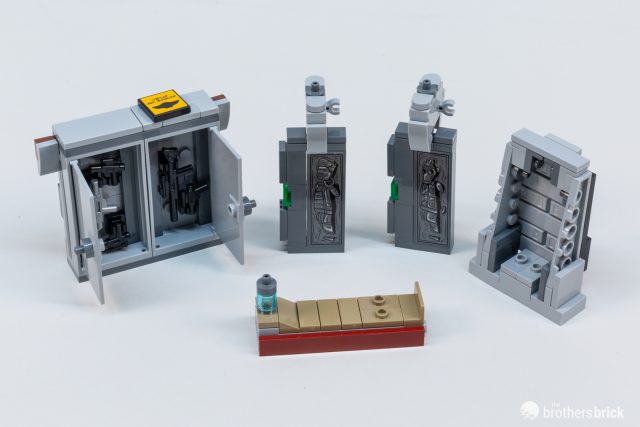 Up front, the upper deck area is also removable, allowing access to the area below it. This upper deck contains the rear two cockpit chairs and a bulkhead with an opening door. It’s also where Grogu and his egg bassinet are placed, perilously close to the container of the Frog Lady’s eggs from Chapter 11: The Heiress.
Up front, the upper deck area is also removable, allowing access to the area below it. This upper deck contains the rear two cockpit chairs and a bulkhead with an opening door. It’s also where Grogu and his egg bassinet are placed, perilously close to the container of the Frog Lady’s eggs from Chapter 11: The Heiress.
There’s just one more section left in Box 1, and that’s the upper hull cladding on the tail, which is built as one large piece that can be removed later for access. Here’s the bottom of it that shows the construction.
 Box 2’s subassemblies are all removable for access, with the exception of the forward cannons. Rather remarkably, that means that something close to half the set’s elements are contained in removable subassemblies, thanks in large part to the two huge engines. The first two sections to be built at the fore and aft wing segments, which will sit on either side of the main cross-member that holds the engines.
Box 2’s subassemblies are all removable for access, with the exception of the forward cannons. Rather remarkably, that means that something close to half the set’s elements are contained in removable subassemblies, thanks in large part to the two huge engines. The first two sections to be built at the fore and aft wing segments, which will sit on either side of the main cross-member that holds the engines.
The engines come next, and they’re by far the most complex portions of the entire build. The cross-member is made of Technic plates sandwiched between tiles for strength, while the engines are cylinders of stacked SNOT bricks arranged radially. The design is very reminiscent of the body of the 21309 NASA Apollo Saturn V. Alternating plate and curved slope segments are attached to this inner core to create the smooth engine exterior.
The engine cores are so part-dense that once this section is complete, it weighs nearly as much as the rest of the ship, but it feels very sturdy and the rigidity is confidence-inspiring.
Now there’s just a few sections of the ship left to build: the canopy, escape pod, and front blaster cannons. The canopy is actually a long segment that stretches from the nose almost back to the engines. It’s got some clever building to it, but both the smaller side windows and the main canopy are lackluster. The minifigure-scale 75292 Razor Crest received a new element for its canopy, and that’s often been the case with UCS sets. The combo of three main transparent elements to create the curving canopy honestly works fairly well, but it does leave an awkward divot in the middle at the front since the curves on the middle windscreen don’t match that of the panels. There’s also an inaccurate bit of grey protruding toward the nose on top. The side windows, however, are much worse. This would have been the perfect opportunity to introduce the 1x3x2 curved arch in trans-clear (the same element that’s used in grey on either side of the windows). Instead, we’re treated to a murky mess of stacked plates and a regular slope, which is technically transparent but hardly see-through.
The last two bits to build are the combined info placard and minifigure stand, and the brick-built blurrg. We’ll look more at the blurrg later, but the stand is very typical fare, as they’re pretty well standardized across UCS sets with a two-wide black plate section with just a few exposed studs for placing the minifigures.
The completed model
So many LEGO vehicle models are modified in scale from their on-screen counterparts, that it almost seems weird to handle a large spaceship that’s properly in scale, and it’s awesome. In case it wasn’t clear from the opening, I love the Razor Crest. It’s a perfectly Star-Warsy vessel, and it looks amazing in full detail at this scale.
The previous Razor Crest set from 2020, 75292 Razor Crest, was a solid model and already quite large at $130 USD and over 1,000 pieces. But it’s indicative of the scaling down that so many LEGO sets go through (which to be clear, is not inherently a problem, because even $130 models already strain most people’s budgets). But it’s simply cool to see the ship done up large. the UCS version positively dwarfs the previous set.
Now, a word about the scale. There are a few ways to calculate minifigure scale (since minifigures are not even remotely an accurate scale model of a human) but a common method is that 1 foot = 1 stud. Using this rubric, the Razor Crest falls just a little over the scale target, at 89 studs rather than the 79 that scale would bring. But it’s certainly close enough to satisfy me, and as I said, that’s not the only way to calculate the scale.
In any case, it’s not that the Razor Crest is first UCS set to be minifigure scale—both the 75192 UCS Millenium Falcon and 75313 UCS AT-AT were roughly minifigure scale. But both the Falcon is so huge as to be a logistics nightmare to move, relegating it to a table prop rather than a functional vehicle toy. And the AT-AT on its spindly legs suffers much the same fate. The Razor Crest, on the other hand, is quite easy to move around, albeit carefully. The manual includes guidance on how to move it, though unlike some other UCS models (looking at you, AT-AT), I found in practice the model is quite robust and actually needs even less careful handling than the instructions indicate. What you cannot do, though, is make the instinctive move of lifting the model by its armpits, which is to say, beneath the wings. If you do, you won’t damage anything, but you’ll lift the engines and leave the ship behind!
Moving on, let’s take a look at the details on this monster model. On the outside, there are two side hatches, plus the large cargo ramp at the rear. All three work splendidly and really feel like spaceship hatches rather than just hinged plates. The pistons on either side of the rear ramp are an especially nice touch, as they extend and retract with the ramp.
All three openings have a foldaway section that extends to meet the ground; it’s not quite as nifty as the sliding extensions seen on-screen, but it works well enough.
The front of the ship looks wonderfully detailed with the giant aftermarket repeating heavy laser cannons, and the yellow striping looks fantastic, even if it is helped a bit by stickers.
Up top, the escape pod is very similar to the one on the smaller 1,000-piece model, but it fits in much better here. It has an opening lid and room for one minifigure.
Now let’s take a look at all the removable sections, starting with the canopy. Oddly, the canopy is not attached to the model at all, instead held in place by gravity only. It doesn’t slot in much, so tipping the model even a bit will cause it to fall off, which seems like a big miss for me, as engineering some sort of stronger attachment would be trivial.
The cockpit is wonderfully detailed with designs old and new (though none exclusive to this set), and the pilot’s chair up front swivels. The rear two chairs are part of that upper deck that lifts out that we saw earlier.
On top, in addition to the cross-member with the engines lifting off, three more large sections are also removable, effectively stripping the entire top hull off to allow limited access to the interior.
Looking down inside, we can see all the interior details from the frozen bounties to Boba Fett’s armor. It all looks great, but as mentioned previously, is rather difficult to access, hammering home that this is first and foremost a display model, not a playset.
Sadly, the Razor Crest will grace our screens no more after its extremely untimely demise near the end of season 2. That has no bearing on my review of this model, but I’m salty because, in my opinion, the Razor Crest was the coolest on-screen ship since the original trilogy (and it reminds me more than a bit of Serenity). Don’t get me wrong; Mando’s new Naboo N-1 Starfighter is awesome, and presumably way faster. But just look at these two together. This is like switching from a Winnebago to a Corvette. Both have their qualities, but they’re so radically different that comparing them is nearly impossible. Give the N-1 folding wings and you could probably stow in inside the Razor Crest.
The minfigures
The Razor Crest includes three traditional minifigures, plus Grogu in his hovering pram, and a blurrg. All of them attach to the info placard base.
Both the Mandalorian and Grogu are exclusives to this set—well, sort of. Grogu is not new, but this is the first set in minifigure-scale to include his hovering pram with accurate colors, although it’s made of common elements (the 2021 Star Wars Advent Calendar included a grey version). The Mandalorian, meanwhile, is a new version unique to this set.
Mando is an upgraded version of the figure from the 75292 Razor Crest set with printing on the (now dark grey) arms, extra printing on the helmet, and a hairpiece for when Mando has his helmet off. It’s also only the second time that Din’s head has been a proper, printed headpiece rather than just solid black, following the one in 75325 The Mandalorian’s N-1 Starfighter earlier this year.
 The other two minifigures are an unnamed Mythrol whom Mando captures as a bounty in the first episode, and Kuiil, the gruff but lovable Ugnaught Mando befriends on Arvala-7. Both are exclusives to this set, and Kuiil features a new head element that incorporates his cap and goggles into a single mold. Kuiil’s brick-built blurrg is also included, and of course, it’s rideable.
The other two minifigures are an unnamed Mythrol whom Mando captures as a bounty in the first episode, and Kuiil, the gruff but lovable Ugnaught Mando befriends on Arvala-7. Both are exclusives to this set, and Kuiil features a new head element that incorporates his cap and goggles into a single mold. Kuiil’s brick-built blurrg is also included, and of course, it’s rideable.
The blurrg is a quick build around a SNOT core. The tail, head, and arms have a little bit of movement, but the legs are fixed. It’s a good build and it looks great, but I’d still love to have a nice molded version that matches the style of many of the other LEGO creatures about this size.
Conclusion & recommendations
From a construction standpoint, the UCS Razor Crest is a fantastically designed set in most regards. The ship’s angular lines are captured well, and the engineering to support the massive engines—not to mention the engineering on the engines themselves—is spectacular. However, the design is not above critique. You may note that the exterior hull doesn’t quite match that of the on-screen ship, which is battered bare metal, giving the vessel a silvery satin finish. LEGO has a few colors that come close to that, and this set’s light bluish grey is not one of them. Either flat silver (AKA silver metallic) or pearl dark grey (AKA titanium metallic) would have been absolutely fantastic alternatives. It’s true this would have required LEGO to produce quite a few new elements in those colors, but this is a $600 flagship set for one of LEGO’s most well-known themes. The decision to go with light bluish grey is a disappointing shortcut for a set that deserves better.
As I mentioned earlier, the design of the removable canopy also feels hasty. It comes loose a little too easily, lacking even a single stud or clip connection to the ship, and the canopy itself really deserved the same new element treatment the smaller version received. The roof panels and engine cross-member could also have been engineered with a removable pin to lock them onto the fuselage, similar to the brilliantly designed 10294 Titanic set. Finally, there’s the inexplicably still stickered info placard, which feels cheap in a set that costs this much. Yes, it’s difficult to print blue or white on black, but that’s not an insurmountable roadblock, and LEGO printed the white text info placard for the recent Technic Ferrari, a set that one-ups the Star Wars UCS line in every aspect of the presentation.
The previous Mando minifigure versions were already great, so there really wasn’t a lot of room to elevate the design for this one, but the new arm and helmet printing still manages to feel like an upgrade. Kuiil is the true exclusive here, as a character who got quite a lot of screen time in the show, and his new molded head is fantastic. The blurrg and Mythrol are both solid entries as well, if less interesting. Only Grogu is not exclusive, though technically his hover pram is.
$600 is a lot to spend on a LEGO set, and this isn’t even the most expensive Star Wars set you can buy. We’re keenly aware that this set won’t be in the budget for many fans, regardless of how cool it is. But for those who’ve got expendable income to drop on a 6,000-piece replica of one of Star Wars’ coolest ships, this is a great set, even if it’s not perfect. It’s an engaging build that results of a model that’s both fun to look at and to fly around.
75331 The Razor Crest includes 6,187 pieces and will retail for US $599.99 | CAN $759.99 | UK £519.99. It will be available Oct. 3 for VIP members with general availability Oct. 7. It may also be available from third-party sellers on Amazon and eBay.
The LEGO Group provided The Brothers Brick with an early copy of this set for review. Providing TBB with products for review guarantees neither coverage nor positive reviews.


















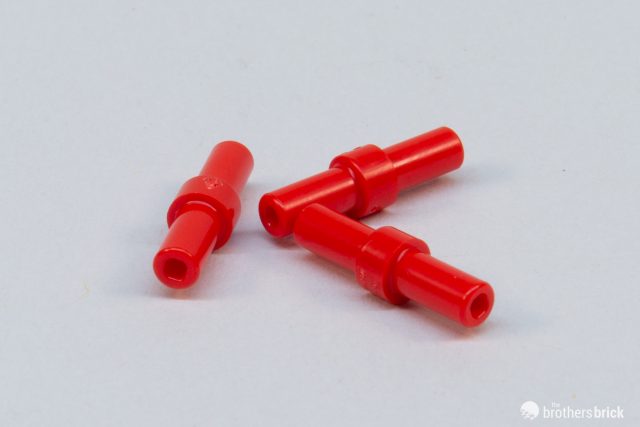




















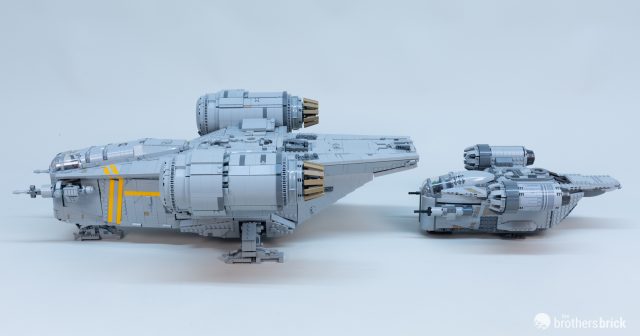


















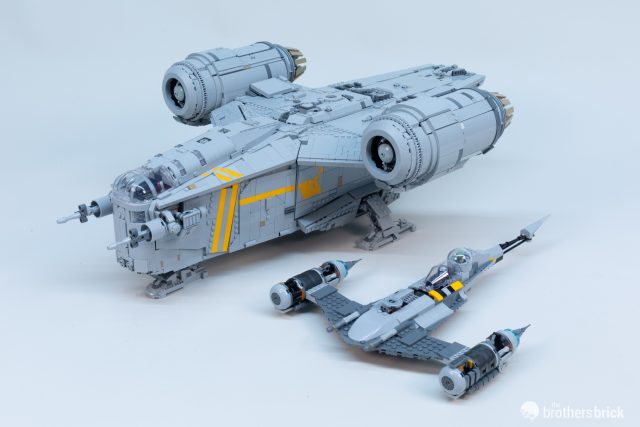






























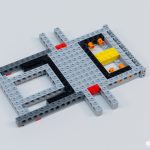



















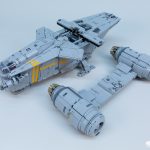


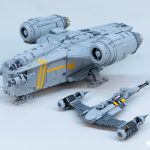











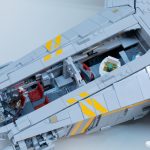










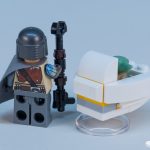





What time will this be released on oct 3rd?
Great review. One of the rare “passes” for me on a SW UCS set. Based on all the points you mentioned in your conclusion and that I already own the Hasbro HasLab Razor Crest which is awesome! I’m fine with my smaller scale Razor Crest Lego since that set looks great as is.